
Tom arrives at Puerto Rico’s San Juan International Airport in 1972 with a stuffed Rhinoceros Iguana, Cyclura cornuta, on loan from the American Museum of Natural History. This was the start of Tom's 3-year field study of the behavior and ecology of the Mona Iguana, Cyclura stejnegeri (formerly Cyclura cornuta stejnegeri)—his doctoral research for Cornell University's Department of Ecology & Evolutionary Biology, completed in 1977. This specimen was missing its tail and was removed from an old diorama exhibit at the AMNH. A young woman who was photographing tourists with a Polaroid camera in the airport took this photograph.
One for the Road
Written by Thomas Wiewandt in September 2002
In memoriam of Charles Herbert Lowe, Jr. (1920-2002), esteemed Professor in the Department of Biological Sciences at the University of Arizona (1950-1995)
Whenever southwestern herpetologists band together—in the field or at formal meetings—conversation invariably turns to stories about one man, The Man, who will will always loom big in the annals of desert ecology and mythology. After many years, I affectionately called him “Uncle Chuckles.” Before then, he was simply “Dr. Lowe.” Because of him, I moved to Tucson in 1967—more importantly to the Sonoran Desert—to begin graduate studies under his supervision at the University of Arizona; and three years later, I moved away, because of him. The specifics would make any rational person cringe, but details are unimportant now. That’s the way things were in those days.
Keep in mind that in many ways recollections and lasting impressions often say more about the writer than the person being written about. Donna Howell—a non-Lowian grad student back in the late sixties who had a fondness for the man—coined her own definition of a cline: “Charles Lowe and all of his graduate students.”
There were a lot of us in Dr. Lowe’s lab at the time, 14 to be exact, all trying to second-guess our prof’s next move. Along with everyone else, I was learning lessons in life, diplomacy, and survival. We were advised that the best way to get people to act is to make them mad. It certainly worked on us, to a point, but I still question the merit of this tactic—an attention-grabber for sure, but the outcome is not always predictable. When teaching, we were reminded to keep the message simple and focused, stressing that if students remembered just one point from an hour’s lecture, we could claim a victory. When writing, we were encouraged to structure paragraphs with the key points up-front for emphasis and clarity, and to work a little “Hemingway” into our descriptive prose. And when contemplating the meaning of life and death, we must never forget that “Surviving the extremes, not the means, determines long-term success.”
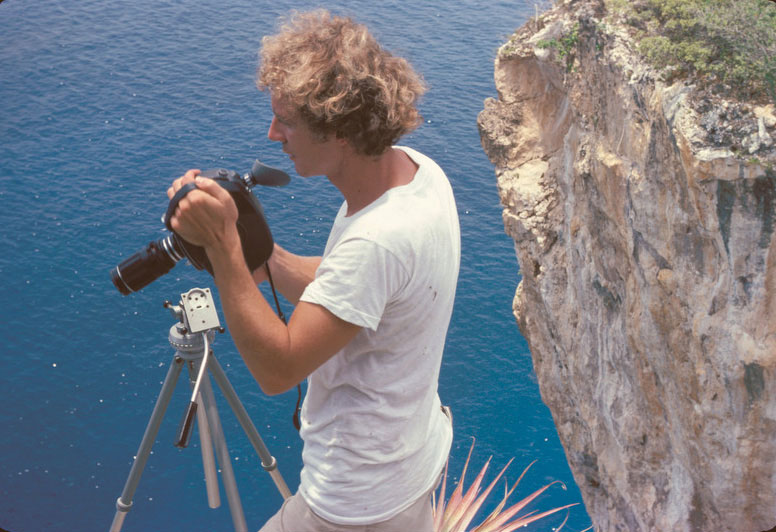
1975 portrait of Thomas Wiewandt on Mona Island, Puerto Rico, with Beauleau 16mm motion picture camera in hand, while working on his first motion picture film project. This footage led to the production of An Island Shall a Monster Make, narrated by David Attenborough and broadcast in 1981 as part of the BBC's popular Wildlife On One television series. Tom was the program's Producer-Cinematographer.
We also heard about countless projects in the works, safely tucked away, at home, “under the bed.” Every “new” idea, it seemed, was quietly aestivating among notes, unfinished manuscripts, and photographs, “under the bed.” To my knowledge, no graduate student ever came close to seeing what was really under that bed. But real or imagined, we knew that it had to be a mighty big bed to accommodate such a big, big man.
In an atmosphere of respect tempered by fear—that’s fear with a capital F—we learned to expect the unexpected. When I shared with fellow grad students my ambition to minor in art, a couple of the “old-timers” in our group smiled with assurance that Dr. Lowe would boot my crazy idea out of the lab. Undaunted and naive, I waited in line for my turn with The Man. Much to everyone’s surprise, he beamed with enthusiasm at the suggestion and launched into tales of admiration for the artistic talents of Robert Stebbins and Fran (Frances) Zweifel. Under the guidance of Donald B. Sayner, Fran was the University of Arizona’s first graduate student in the field of scientific illustration within the Department of Biological Sciences. Unknown to Dr. Lowe’s later grad students, she had worked as an illustrator in his lab, he had served on her steering committee, and her thesis became a wonderfully useful reference book—published as A Handbook of Biological Illustration (1961 & 1988, Univ. Chicago Press).
In spite of Dr. Lowe’s encouragement to pursue interdisciplinary studies, I never did minor in art. Professors in the Art Department expressed little interest in opening their doors to a science major (in 1968)—without even asking to see samples of my work. So instead, I chose two years of training in scientific illustration and photography under the direction of Donald Sayner. These classes proved to be among the most inspiring and influential of my graduate career, classes that have served me well to this day. Thank you Don and Uncle Chuckles.
With 14 grad students clamoring for the attention of one reclusive professor, I think most of us treasured those times when we could share a few moments alone with The Man over a quick meal between classes. For me, one lunch break was more memorable than all others. After downing a sandwich at a fast food restaurant on east Speedway, we headed “home”—back to the University—in the Lowemobile, a big ol’ faded green GMC Carryall that seemed worse for the wear inside than out. Suddenly, a guy cruisin’ by on an “Easy Rider” style motorcycle switched lanes, cutting directly in front of us, with little room to spare. Uncle Chuckles cursed and fumed, and as we approached the next red light, he leaned on the horn and wouldn’t let up. Sensing what was about to happen, I shrank in my seat. The cyclist turned around, challenging us to pull over. We did. Mind you, this was a pretty mean looking dude. He parked his cycle and headed for our car. Without hesitating, Dr. Lowe shoved the door open and climbed out, all 6’3” puffed up to a stature that would make any testosterone-charged iguana proud. Very few words were exchanged, but Easy Rider was clearly in melt-down—he apologized. After crawling back into the wagon, the good professor leaned my way to say, “One of these days I’ll get my ass kicked by pulling a stunt like that!”
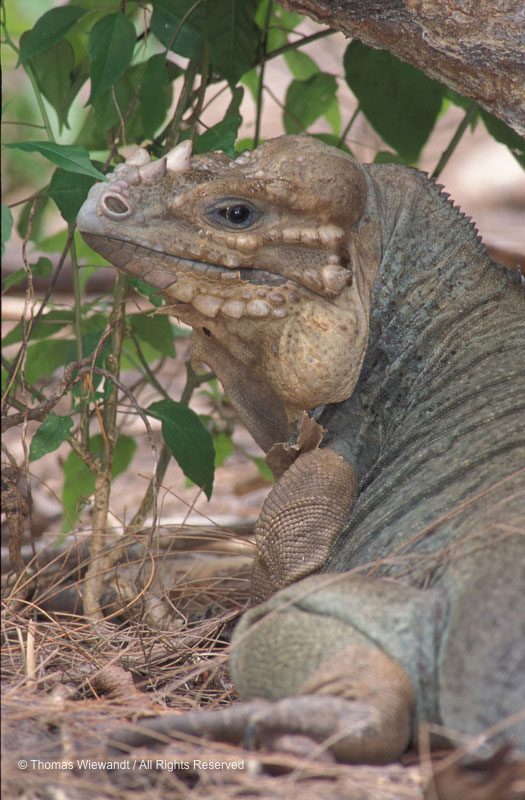
Male Mona Iguana, a West Indian rock iguana endemic to Mona Island, Puerto Rico. Cyclura stejnegeri is the currently accepted name. Thomas Wiewandt lived on Mona for three years to study the behavior and ecology of this lizard, his doctoral research project, completed in 1977, for Cornell University's Department of Ecology & Evolutionary Biology. During this time on the island, he also shot 20K feet of motion picture footage, which led to the production of An Island Shall a Monster Make, a 30-minute film narrated by David Attenborough and broadcast in 1981 as part of the BBC's popular “Wildlife On One” television series. Tom was the program's Producer-Cinematographer.
One of Uncle Chuckles’ most endearing attributes was his genuine love for the plants and animals he studied. He delighted in the subtleties of beauty and behavior, things that turned me on far more than counting scales or measuring oxygen consumption in animals under stress. In those days, most of his students were either pawing through pickled specimens or experimenting on critters round the clock. Dr. Lowe respected me as a loner but made it clear he would have preferred a better fit with his group dynamic, a dynamic that was rigidly closed to outsiders by the way. He saw each piece of the puzzle vital to understanding “the big picture.”
When the time came for me to prove what I was really made of—by undertaking a solo stint in the wilds of Sonora, Mexico—I felt a bit like a kid setting off for his first day at school, even though I was pretty well seasoned as a field biologist by then. Uncle Chuckles gave me some pointers on where to find the burrowing treefrogs I had intended to study for my Masters research. I knew very little Spanish, and with a pat on the head, he gave me two final pieces of fatherly advice: “Never camp near a big city. And when you’re out in the boonies, if anyone stops to see what you are doing, just say Estudiando ranas y sapos (I’m studying frogs and toads), and they will laugh and go on their way.” So I had a mantra for my first hour on the road: Estudiando ranas y sapos, Estudiando ranas y sapos.
Shortly after crossing the border in Nogales late that afternoon, all hell broke loose. Wind and rain of Biblical proportion pounded my little VW bug. This was early July, the onset of our monsoon season, what Dr. Lowe called “A First-Nighter,” the only night of the year when the desert really goes berserk. Within minutes, I caught glimpses of critters hopping across the roadway, and voices filled the air. As puddles grew, toads gathered, screaming for sex as though there would be no tomorrow. Male spadefoots pounced on anything that moved, while Sonoran green toads called more patiently from the sidelines. The orgy had begun, here at least.
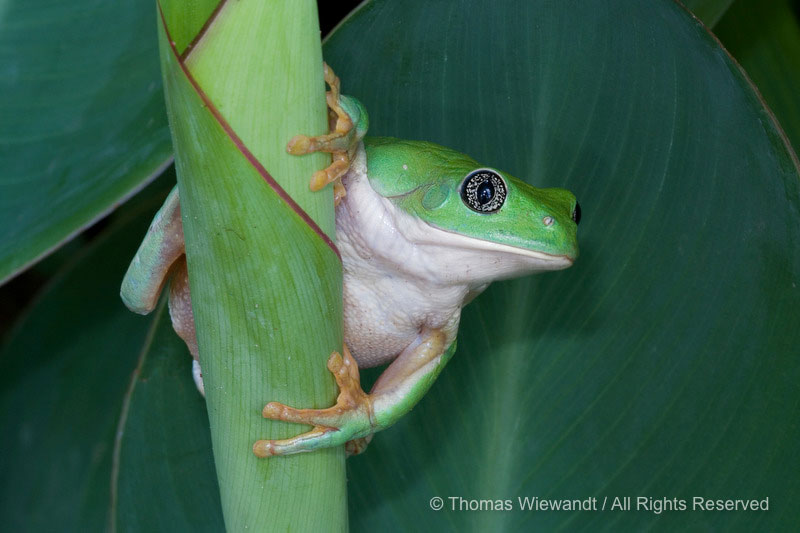
Mexican Leaf Frog, Agalychnis dacnicolor, in Alamos, Sonora, Mexico. Tom studied the reproductive biology and behavior of this species at a pond near Alamos for his MS thesis research (1970), Dept. of Biological Sciences, University of Arizona.
My destination, however—prime burrowing treefrog habitat near Navajoa—was still bone dry. Dr. Lowe had prepared me for this, suggesting that if time and opportunity should present itself, I should head east towards the subtropical forest in foothills of the Sierra de Alamos. Massive thunderheads loomed over those mountains, and sure enough, rain-filled stock ponds and ditches were alive with breeding frogs and toads, more species than I could identify. But burrowing treefrogs were scarce in the highlands, and their coastal habitat remained parched. So I kept returning to the Sierra de Alamos. This road was narrow and well traveled by locals, so my mantra, Estudiando ranas y sapos, came in handy—and it worked as predicted.
Several days later, I discovered a small population of stunning green treefrogs breeding at a tiny pond nestled in the short-tree forest near the town of Alamos. Their calm disposition, chameleon-style walk, and habit of hanging clusters of eggs in the canopy hooked me immediately. After observing these magical animals for two more nights, I phoned Dr. Lowe for some background. I learned that what I had found is Agalychnis (aka Pachymedusa) dacnicolor, a subtropical species that reaches the northern limit of its range near Alamos, and it’s a frog about which little was known. So I popped the question: “Can I switch thesis projects?” Without hesitation, he suggested that I go for it.
At the time I was extremely grateful for a decision that would allow me to spontaneously change directions, but it wasn’t until years later that I fully appreciated the magnitude of what had happened during that brief telephone conversation. How many professors would offer a student the opportunity to switch study animals mid-stream—without a formal proposal—especially when abandoning an idea funded by a small grant from an outside organization (in this case the Arizona-Sonora Desert Museum)? In this arena, Charles Lowe excelled in practicality. He thoroughly understood the rigors of fieldwork and the need to respond quickly to the unexpected. Curiously, the same philosophy spilled over in my photographic training: Don Sayner used to say, “When it rains, shoot rainy-day pictures.” As a result, that summer in Sonora ranks among my most gratifying life experiences, and preparing my thesis was a pleasure because of it.
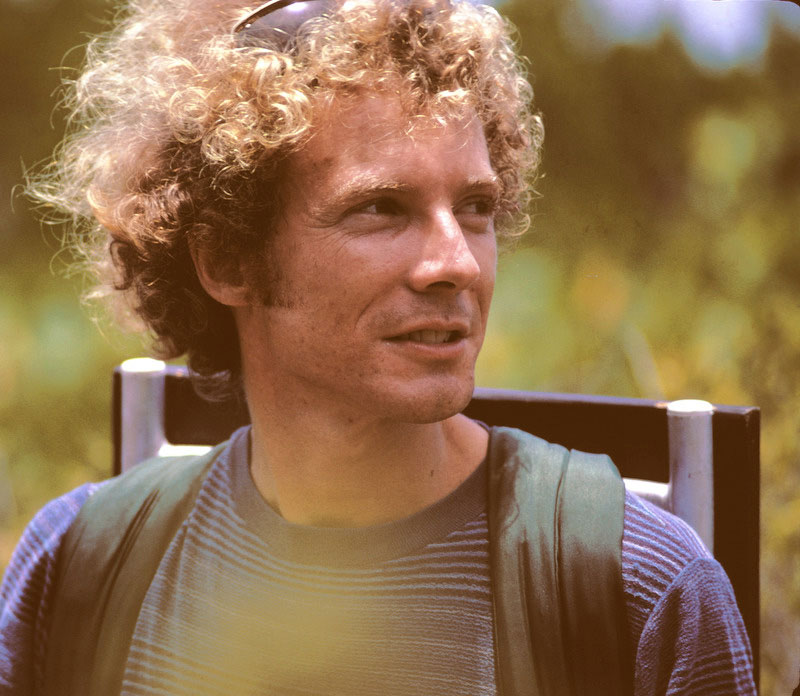
1975 portrait of Thomas Wiewandt on Mona Island, Puerto Rico, photographed while he was studying the behavior and ecology of the Mona Iguana, Cyclura stejnegeri, the topic of his doctoral research for Cornell University's Department of Ecology & Evolutionary Biology, completed in 1977. Tom lived on Mona from 1972-1975, and during this time he also shot 20K feet of motion picture footage, which led to the production of An Island Shall a Monster Make, narrated by David Attenborough and broadcast in 1981 as part of the BBC's popular Wildlife On One television series. Tom was the program's Producer-Cinematographer.
Professor Lowe received an unanticipated and just reward from this Mexican adventure. Among the mystery animals that turned up at my study site was one that had the appearance of a narrow-mouthed toad pumped-up on steroids. Being totally unfamiliar with the tropical flora and fauna in the Alamos area, I failed to recognize the significance of this rare animal—Hypopachus variolosus (Microhylidae). When Dr. Lowe saw the six live males that I brought back with me, along with detailed field notes and their tape-recorded calls, he was ecstatic. Only one individual had ever been reported from the Sierra de Alamos, a specimen collected by Merv (Mervin) Larson 11 years earlier. Dr. Lowe had always regarded this lone specimen as suspect because it represented a 330-mile northern range extension for the genus in western Mexico. At long last, he was able to resurrect and confirm a discovery that had been filed “under his bed” for more than a decade, which led to a publication in Herpetologica.
Before leaving Tucson to pursue my Ph.D. among behavioral ecologists at Cornell University, I stopped by Uncle Chuckles’ house—literally on the way out of town—to give him a framed collage as a token of my appreciation. As always, he was very grateful for such gifts, but this was a bold move on my part. Students were never welcome at his home; and in fact, I don’t believe I had ever met his wife Arlene. She greeted me warmly and said, “I’ve just returned from the tamale factory—won’t you stay for dinner?” But before I could answer, the good professor cut in with “At least give him one for the road!” Tamales in hand, I smiled and went on my way, wondering if he feared that someone would steal a peek under his bed.
As years passed, I received word that the Lowe house had caught fire and burned to the ground—some speculated that the cause was spontaneous combustion. This shattering experience altered the good professor’s life in profound ways, a story best told by his younger students.
But one thing is now certain: none of us will ever know for sure what was hiding under his bed.
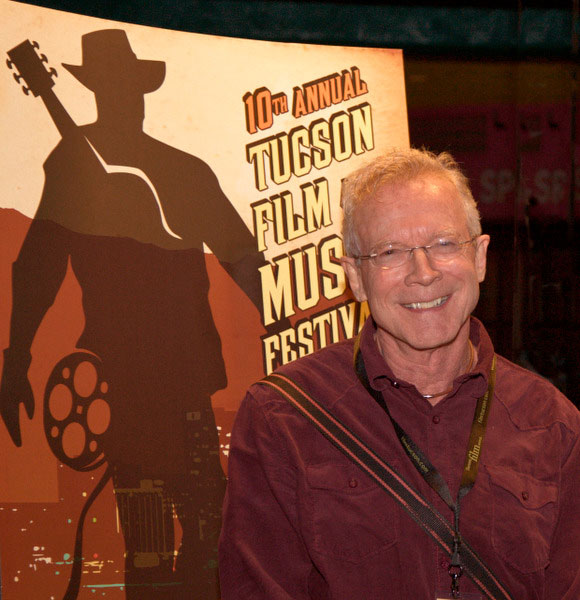
Filmmaker Thomas Wiewandt at the 2014 Tucson Film & Music Festival, Tucson, Arizona, USA, for the screening of his film Desert Dreams: Celebrating Five Seasons in the Sonoran Desert. This award-winning film is being broadcast as a pledge drive program on Public Television stations across the USA (2015-2018). photo by Joshua Adels